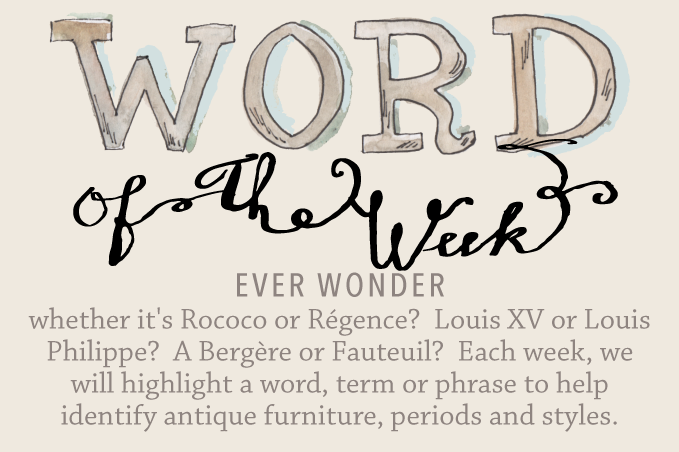Lorem ipsum dolor sit amet, consectetur adipiscing elit, sed do eiusmod tempor incididunt ut labore et dolore magna aliqua. Ut enim ad minim veniam, quis nostrud exercitation ullamco laboris nisi ut aliquip ex ea commodo consequat.
Most Popular Blog Posts

Ever wonder whether it's a Rococo or Régence? Louis XV or Louis Philippe? A Bergère or Fauteuil? Each week, we will highlight a word, term, or phrase to help identify antique furniture, periods, and styles.

TRUMEAU
tru·meau [troo-moh; French try-moh]
noun, plural tru·meaux [troo-mohz; French try-moh]
1. Architecture. the pillar or center post supporting the lintel in the middle of a doorway, especially in a church.
2. an overmantel treatment of 18th century France consisting of a pier glass surmounted by an oil painting or decorative often carved panel.
Origin: late 19th century < French: literally, 'calf of the leg'.

Detail of the portal of the Cathédrale Saint Sauveur, Aix en Provence
In architecture, the French word trumeau refers to a highly sculpted and decorated column or vertical post used in the center of a large portal or doorway, especially in a church, supporting the lintel and tympanum. First appearing during the Middle Ages, these architectural elements represent an important part of art history and architectural heritage. It wasn't until the early 18th century that the term trumeau became associated with mirrors.

Rare French trumeau with gilded candle sconces mounted to the frame, Château de Villette: The Splendor of French Decor, published by Flammarion, photo by Bruno Ehrs
Invented in France and made popular by the French aristocracy, trumeau mirrors were originally designed to hang on a wall between windows. Because mirrored glass was so expensive at the time, the royals and aristocrats who owned them took great pride and pleasure in showing them off. A common centerpiece of 18th century interiors, these long, rectangular wall mirrors set into paneling were intricately carved, often gilded but almost always painted, and topped with a carved motif or painting.
They served not only as a decorative element, but were also very functional because of the reflective quality of the mirrored glass bringing much needed light to a room. By day the mirror would reflect sunlight throughout a room, and at night it would reflect the candlelight. Candle sconces were hung on the wall on either side of the mirror to increase light or placed in front of trumeaux designed to be hung above a mantel rather than between windows. Some rare trumeaux were designed with gilded candle sconces attached to the frames. Before the use of trumeau mirrors, large panels of mirrored glass were built directly into the walls or boiserie between two windows to add light to a room.

Another rare French trumeau with gilded candle sconces mounted to the frame, Château de Villette

19th Century French Louis XVI Style Painted and Gilt Trumeau Mirror / Item #LO247 / Lolo French Antiques et More

19th Century French Louis XVI Style Painted Trumeau Mirror with Oil Painting / Item #LO3137 / Lolo French Antiques et More
The trumeau's large size makes it a very versatile piece. It can easily prop against a wall on it's own or be used as a focal point over a mantle or piece of furniture. Mirror, mirror on the wall... what's your favorite way to use a trumeau mirror? Let us know!
À Bientôt!

Ever wonder whether it's a Rococo or Régence? Louis XV or Louis Philippe? A Bergère or Fauteuil? Each week, we will highlight a word, term, or phrase to help identify antique furniture, periods, and styles.

TABLE DE DRAPIER
tab·le·de·drap·ier [tah-bl-duh-drap-yay]
noun [tah-bl-duh-drap-yay]
1. table of a cloth merchant
Origin: 1325-75; <From Anglo-French; Old French drapier, equivalent to drap cloth + -ier

Sketch of a Draper's or Upholsterer's Shop by Gustave Doré (French, Strasbourg 1832–1883 Paris), Metropolitan Museum of Art
Dating as far back as the 17th and 18th centuries, the table de drapier or French draper table was an essential piece of furniture used in a cloth merchant's shop. Designed to have a generous work surface, these large rectangular tables provided the perfect surface area for unfurling, measuring, and cutting long swaths or bolts of fabric. They often had multiple drawers on each side so that seamstresses could work on both sides and always have access to cutting tools and sewing necessities such as shears, snips, and scissors. Most tables also had a lower shelf for storing and stacking additional rolls of beautiful silk, cotton, and linen fabrics for the noble and wool, cotton, and linen for the common people. The tables functioned in a utilitarian fashion, but many were very beautiful work tables — such as the ones below. Considered the crème de la crème of draper tables, these both came from ateliers that catered to the the rich and bourgeois. Fine linens and silk brocades were definitely stacked on those shelves.

Mid-19th Century French Louis Philippe Period Walnut Draper's Table / Item LOPD52 / Lolo French Antiques et More

Grand 18th Century French Directoire Period Walnut Draper's Table with Marquetry Band / Item #LOPC130 / Lolo French Antiques et More
Today, these timeless tables can be easily mixed into both modern and traditional decor. Versatile and functional, tables de drapier can be used as console, display, or hall tables, as well as beautiful kitchen islands or serving tables. Laurent and I used a large one at my son's 2021 wedding that was held at our store. It was the perfect table for a huge charcuterie spread, allowing guests to serve themselves from both sides while enjoying some mulled wine and other spirits during the cocktail hour. The shelf provided plenty of extra storage for plates and glasses, while extra utensils, serving pieces, and napkins were hidden away in the drawers. And the smaller table was recently used at a beautiful baby shower.



Place one against an empty wall to show off your favorite collection of French pottery, linens, breadboards, or baskets. And with drawers and a shelf, the table de drapier is a perfect choice for stylish storage that makes a statement!

À Bientôt!

Mother's Day is just two weeks away. And while every day is a great day to honor and celebrate the wonderful women in our lives, let us help make May 14th just a little more special for the ones who have raised us, loved us unconditionally, and always cheered us on. A thoughtful gift doesn't always require a splurge, and our 20 stylish suggestions include presents that will make everyone on your list — from your mother, grandmother, stepmother, daughter, daughter in love, sister, aunt, friend, mentor, or new mom who's just welcomed a little one into the world — feel loved and adored on any random day, but especially this Mother's Day!

1. Natural Oyster Shell and Coral Mounted on 19th Century Italian Giltwood Urn Fragment 2. Set of Six Vintage Longchamp White Majolica Oyster Plates with Master Server Dish or Platter 3. Pair of Vintage Silver Metal Italian 3-Light Sconces with Half-Shades 4. Clam Shell and Cup Coral with Seashells Mounted on 19th Century Italian Giltwood Fragment Base 5. Birdnest Coral with Seashells Mounted on 19th Century Italian Giltwood Urn Fragment Base 6. Vintage Hand Blown Green Glass Soda Syphon Seltzer Bottles 7. 19th Century French Louis XVI Style Giltwood Corner Chair with Original Needlepoint Seat 8. Early 20th Century Antique French Grape Hod or Gathering Basket 9. Vintage 20th Century Four-Light Pink and Blue Murano Glass Chandelier 10. 19th Century French Louis XVI Style Painted Three-Drawer Commode 11. Aux Anysetiers du Roy Herbes de Provence in Stone Crock. 12. Nina's Paris L'Original Marie Antoinette Loose Leaf Tea Tin, 3.5oz 13. Famille Perronneau Provence Honey, 4.4oz 14. Rare 19th Century French Pot de Confit or Confit Pot with Dark Green Glaze and Handles 15. Collection of 9 Early 20th Century Italian Herbiers from Florence, Italy Set in Large 9 Paned White Window Frame 16. Large 19th Century Spanish Terracotta Olive Jar with Green Glaze and Handles 17. 19th Century Italian Rococo Style Painted and Parcel Gilt Console Table 18. Les Macarons de Paris Tea Towel by Torchons & Bouchons 19. Herbs de Provence Tea Towel by Torchons & Bouchons 20. How to Be Parisian Wherever You Are: Love, Style, and Bad Habits
Lolo’s 2023 Mother's Day Gift Guide is a delightful mix of unique finds, both big and small, with a sprinkle of practical and useful gifts mom won't buy herself. Each meaningful gift is sure to make her smile — whether she's a minimalist who appreciates the simple things or a more is more gal who loves collectibles and fun finds, a gardener with a green thumb who sees the beauty in everything or a woman who can bring home the bacon and fry it up in a pan. This Mother's Day, let's give her SOME THINGS to chirp about!
À Bientôt!


TRUMEAU: WEDNESDAY'S WORD OF THE WEEK

Most Popular Blog Posts


ALL THINGS FRENCH
that strike our fancy














ALL THINGS FRENCH
that strike our fancy



















